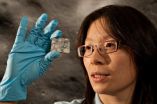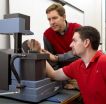(Press-News.org) COLUMBUS, Ohio – New research shows that loss of a gene called NFKBIA promotes the growth of glioblastoma multiforme, the most common and deadly form of brain cancer, and suggests that therapies that stabilize this gene may improve survival for certain glioblastoma patients.
The study was published recently in the New England Journal of Medicine.
"We show that NFKBIA status may be an independent predictor of survival in certain patients with glioblastoma," says senior coauthor Dr. Arnab Chakravarti, chair and professor of Radiation Oncology and co-director of the Brain Tumor Program at the Ohio State University Comprehensive Cancer Center – Arthur G. James Cancer Hospital and Richard J. Solove Research Institute (OSUCCC – James).
"We also show that this gene plays a key role in glioblastoma behavior, and that it could be useful for predicting treatment outcomes," he says.
An estimated 18, 500 new cases of glioblastoma occur annually among Americans, resulting in 12,760 deaths. Average survival after diagnosis is about 12 to 15 months.
Most cases of the disease are driven by over activity of a gene called EGFR (epidermal growth factor receptor). This study shows that loss of NFKBIA (nuclear factor of kappa-light polypeptide gene enhancer in B-cells inhibitor-alpha) and overexpression EGFR are equally potent at driving glioblastoma development.
It also shows that glioblastoma tumors generally show either abnormally high levels of EGFR or loss of NFKBIA, but not both. Normal levels of both genes also occur.
Chakravarti, along with Markus Bredel, an adjunct associate professor of radiation oncology at Ohio State and their colleagues analyzed data from 790 cases of glioblastoma, which they divided into 10 study sets, for gene deletions, mutations, and expression of NFKBIA and EGFR.
Using glioblastoma cell lines and tumor cells from patients, they examined the influence of the NFKBIA gene on tumor-cell growth and sensitivity to temozolomide, the most effective chemotherapy for glioblastoma. Finally, they compared these findings with the outcomes of 570 glioblastoma patients.
These investigations showed the following:
Restoring NFKBIA in tumor cells inhibited their growth and viability and increased the cells' sensitivity to temozolomide.
Restoring NFKBIA suppresses the growth of glioblastoma cells that are driven by overexpression of EGFR.
Patients with both copies of NFKBIA survive significantly longer than did patients with tumors that have lost a copy of the gene (131 weeks and 57 weeks, respectively).
INFORMATION: END
Boston, MA (January 5, 2010) — For parents wanting to reduce the negative influence of TV on their children, the first step is normally to switch off the television set.
But a new study suggests that might not be enough. It turns out indirect media exposure, i.e., having friends who watch a lot of TV, might be even more damaging to a teenager's body image.
Researchers from Harvard Medical School's Department of Global Health and Social Medicine examined the link between media consumption and eating disorders among adolescent girls in Fiji.
What they found was surprising. ...
INDIANAPOLIS – A simpler form of testing individuals with risk factors for diabetes could improve diabetes prevention efforts by substantially increasing the number of individuals who complete testing and learn whether or not they are likely to develop diabetes.
Approximately 60 million Americans, one-third of the adult population, are pre-diabetic. Thirty percent of these individuals will develop Type 2 diabetes in less than a decade, yet most don't know they are at high risk for the disease.
A study published in the January 2011 issue of the American Journal of Preventive ...
Mount Sinai researchers coordinating the largest clinical study to date of "Sarcoid Like" Granulomatous Pulmonary Disease in World Trade Center (WTC) responders have found that the rate of the condition was increased in this group as compared to the records of pre-9/11 FDNY personnel. The study is published online in the American Journal of Industrial Medicine.
The Mount Sinai researchers studied almost 20,000 responders who had an initial exam in the Mount Sinai World Trade Center Medical Monitoring and Treatment Program between July 2002 and September 2007. Overall ...
Spartanburg, S.C., USA, 6 January, 2010 – Researchers at Wofford College discovered that a Border Collie comprehends the names of over 1000 objects, differentiating between names of objects and orders to fetch them. This research deepens the findings of researchers in Germany, who had discovered a dog that knew the names of a couple of hundred objects. Important questions were left open as to how far a dog could go, and whether the dog really understood that the object names were nouns and not commands to retrieve the object.
John Pilley and Alliston Reid answered two ...
The Moon, Earth's closest neighbor, has long been studied to help us better understand our own planet. Of particular interest is the lunar interior, which could hold clues to its ancient origins. In an attempt to extract information on the very deep interior of the Moon, a team of NASA-led researchers applied new technology to old data. Apollo seismic data was reanalyzed using modern methodologies and detected what many scientists have predicted: the Moon has a core.
According to the team's findings, published Jan. 6 in the online edition of Science, the Moon possesses ...
Show enthusiasm, ask questions and bring copies of a resume. These are just a handful of the most common interview tips for job seekers, but a person's posture may also be a deciding factor for whether they land a coveted position – even when the person on the other side of the desk is in a more powerful role.
According to new research from the Kellogg School of Management at Northwestern University, posture plays an important role in determining whether people act as though they are really in charge. The research finds that "posture expansiveness," or positioning oneself ...
Ibn al-Haytham's 11th-century Book of Optics, which was published exactly 1000 years ago, is often cited alongside Newton's Principia as one of the most influential books in physics. Yet very little is known about the writer, considered by many to be the father of modern optics.
January's Physics World features a fanciful re-imagining of the 10-year period in the life of the medieval Muslim polymath, written by Los Angeles-based science writer Jennifer Ouellette.
The feature covers the time when al-Haytham -- banished from society and deprived of books -- came up with ...
COLUMBUS, Ohio – Young people may crave boosts to their self-esteem a little too much, new research suggests.
Researchers found that college students valued boosts to their self-esteem more than any other pleasant activity they were asked about, including sex, favorite foods, drinking alcohol, seeing a best friend or receiving a paycheck.
"It is somewhat surprising how this desire to feel worthy and valuable trumps almost any other pleasant activity you can imagine," said Brad Bushman, lead author of the research and professor of communication and psychology at The ...
AMES, Iowa – Michael Kessler has worked with polymers that repair themselves when they crack. And he's worked with polymers made from vegetable oils. Now he's working to combine the two technologies.
Kessler, an Iowa State University associate professor of materials science and engineering and an associate of the U.S. Department of Energy's Ames Laboratory, is researching and developing biorenewable polymers capable of healing themselves as they degrade and crack.
"If successful, the results of this research will provide biorenewable alternatives to petroleum-based ...
VIDEO:
Extracting mitochondria from a human cell (larger object on bottom right) is a tricky process. NIST researchers recently developed techniques that can surgically remove these tiny cellular engines, potentially enabling...
Click here for more information.
Medical researchers who crave a means of exploring the genetic culprits behind a host of neuromuscular disorders may have just had their wish granted by a team working at the National Institute of Standards and Technology ...


